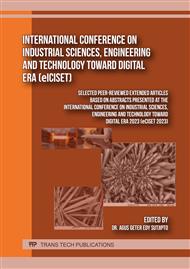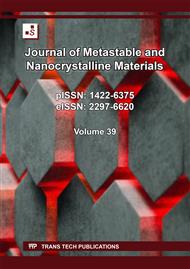[1]
Wenhao Chen, Thien N. Truong, Hieu T. Nguyen, Christian Samundsett, Sieu Pheng Phang, Daniel MacDonald, Andres Cuevas, Lang Zhou, Yimao Wan, Di Yan, "Influence of PECVD deposition temperature on phosphorus doped poly-silicon passivating contacts", Solar Energy Materials and Solar Cells, Volume 206, (2020), Page 110348.
DOI: 10.1016/j.solmat.2019.110348
Google Scholar
[2]
Jia Liu, Bin Liu, Xisheng Zhang, Xiaojia Guo, Shengzhong (Frank) Liu, Improvement of crystallinity for poly-Si thin film by negative substrate bias at low temperature, Thin Solid Films, Volume 629, (2017), Pages 90-96.
DOI: 10.1016/j.tsf.2017.03.050
Google Scholar
[3]
Subhashis Samanta, Debajyoti Das, Nanocrystalline silicon thin films from SiH4 plasma diluted by H2 and He in RF-PECVD, Journal of Physics and Chemistry of Solids, Volume 105, (2017), Pages 90-98.
DOI: 10.1016/j.jpcs.2017.02.013
Google Scholar
[4]
J. Konieczny, L. A. Dobrza?ski, A. Dryga?a, and J. Lelatko, "TEM investigations of laser texturized polycrystalline silicon solar cell," Arch. Mater. Sci. Eng., vol. 56, no. 1, pp.22-29, 2012.
Google Scholar
[5]
Y. Huang et al., "Enhanced light trapping in polycrystalline silicon thin-film solar cells using plasma-etched submicron textures," Sol. Energy Mater. Sol. Cells, vol. 122, pp.146-151, Mar. 2014.
DOI: 10.1016/j.solmat.2013.11.033
Google Scholar
[6]
R. Muhida, A. Sutjipto, T. Matsui, T. Toyama, and H. Okamoto, "Measuring the Electronic Properties of Poly-Si Thin Film Solar Cells Deposited on Textured Substrate," in 2006 IEEE 8th International Conference on Properties and applications of Dielectric Materials, Jun. 2006, pp.309-314.
DOI: 10.1109/ICPADM.2006.284178
Google Scholar
[7]
R Muhida, AGE Sutjipto, Afzeri, T Toyama, H Okamoto, "Relationship between average slope of textured substrate and poly-Si thin film solar cells performance," Materials Research Innovations 13 (3), 246-248, 2009.
DOI: 10.1179/143307509x440424
Google Scholar
[8]
AGE Sutjipto," The effect of CaO addition on the microstructural, mechanical and dielectric properties of pure MgO ceramic," Key Engineering Materials 345, 1609-1612, 2007.
DOI: 10.4028/www.scientific.net/kem.345-346.1609
Google Scholar
[9]
R. Muhida et al., "Crystal growth of polycrystalline silicon thin films for solar cells evaluated by scanning probe microscopy," J. Non. Cryst. Solids, vol. 338-340, pp.682-685, Jun. 2004.
DOI: 10.1016/j.jnoncrysol.2004.03.065
Google Scholar
[10]
J. Wang et al., "Influence of the textured pyramid size on the performance of silicon heterojunction solar cell," Sol. Energy, vol. 221, pp.114-119, Jun. 2021.
DOI: 10.1016/j.solener.2021.04.021
Google Scholar
[11]
P. Fallahazad, N. Naderi, and M. J. Eshraghi, "Improved photovoltaic performance of graphene-based solar cells on textured silicon substrate," J. Alloys Compd., vol. 834, p.155123, Sep. 2020.
DOI: 10.1016/j.jallcom.2020.155123
Google Scholar
[12]
L. K. Wang, J. J. Chen, J. Y. Yu, H. L. Zhao, and J. K. Yang, "Highly textured spray-deposited SnO2:F films with high haze for solar cells," Vacuum, vol. 169, p.108879, Nov. 2019.
DOI: 10.1016/j.vacuum.2019.108879
Google Scholar
[13]
H. Kim et al., "Effect of texturing process involving saw-damage etching on crystalline silicon solar cells," Appl. Surf. Sci., vol. 284, pp.133-137, Nov. 2013.
DOI: 10.1016/j.apsusc.2013.07.051
Google Scholar
[14]
H. Fritzsche, "Amorphous semiconducting Si:H," Bull. Mater. Sci., vol. 2, no. 5, pp.295-315, Dec. 1980.
DOI: 10.1007/BF02908577
Google Scholar
[15]
A. Lotnyk, J. Bauer, O. Breitenstein, and H. Blumtritt, "A TEM study of SiC particles and filaments precipitated in multicrystalline Si for solar cells," Sol. Energy Mater. Sol. Cells, vol. 92, no. 10, pp.1236-1240, Oct. 2008.
DOI: 10.1016/j.solmat.2008.04.016
Google Scholar



